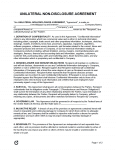Non-Disclosure Agreement (NDA) Template
A non-disclosure agreement (NDA) is a legally binding contract designed to protect confidential information from being disclosed. Commonly employed in business contexts, NDAs are used when a new employee, potential investor, or partner gains access to sensitive information. This legal instrument fosters collaboration and trust among businesses and individuals by safeguarding their competitive advantage from the potential misuse of shared information.
NDAs: By State
- Alabama
- Alaska
- Arizona
- Arkansas
- California
- Colorado
- Connecticut
- Delaware
- Florida
- Georgia
- Hawaii
- Idaho
- Illinois
- Indiana
- Iowa
- Kansas
- Kentucky
- Louisiana
- Maine
- Maryland
- Massachusetts
- Michigan
- Minnesota
- Mississippi
- Missouri
- Montana
- Nebraska
- Nevada
- New Hampshire
- New Jersey
- New Mexico
- New York
- North Carolina
- North Dakota
- Ohio
- Oklahoma
- Oregon
- Pennsylvania
- Rhode Island
- South Carolina
- South Dakota
- Tennessee
- Texas
- Utah
- Vermont
- Virginia
- Washington
- West Virginia
- Wisconsin
- Wyoming
NDAs: By Type (7)
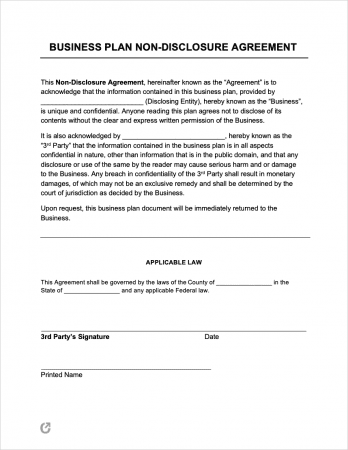 Business Plan – Allows entrepreneurs and other professionals to share their business plan with investors and other businesses without fear of their idea being stolen and utilized.
Business Plan – Allows entrepreneurs and other professionals to share their business plan with investors and other businesses without fear of their idea being stolen and utilized.
Download: PDF, Word (.docx)
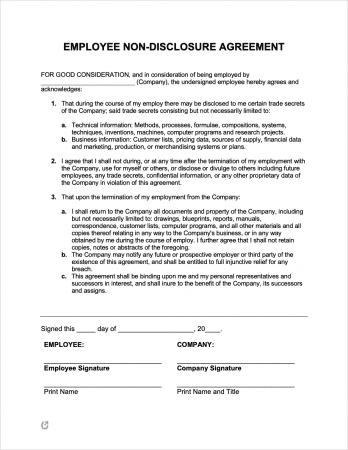 Employee – Used by a company for preventing newly-hired employees or contractors from disclosing the company’s secrets.
Employee – Used by a company for preventing newly-hired employees or contractors from disclosing the company’s secrets.
Download: PDF, Word (.docx)
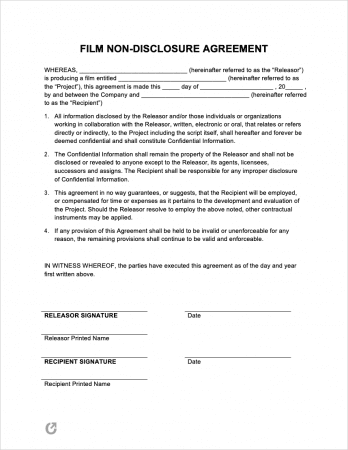 Film (Movie) – Secures a production company’s script, plot, cast, or related information against unauthorized leaks to the public.
Film (Movie) – Secures a production company’s script, plot, cast, or related information against unauthorized leaks to the public.
Download: PDF, Word (.docx)
 HIPAA (Non-Employee) – A HIPPA-compliant form for preventing non-employees from sharing learned information from a healthcare facility.
HIPAA (Non-Employee) – A HIPPA-compliant form for preventing non-employees from sharing learned information from a healthcare facility.
Download: PDF, Word (.docx)
 Mutual (Bilateral) – A contract employed when companies or individuals exchange confidential information with each other, ensuring mutual protection.
Mutual (Bilateral) – A contract employed when companies or individuals exchange confidential information with each other, ensuring mutual protection.
Download: PDF, Word (.docx)
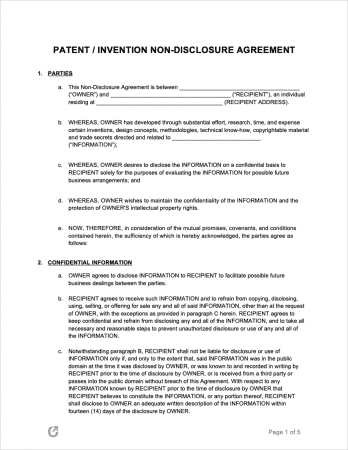 Patent – Utilized by inventors and companies to safeguard information related to new inventions, designs, ideas, processes, or other trade secrets.
Patent – Utilized by inventors and companies to safeguard information related to new inventions, designs, ideas, processes, or other trade secrets.
Download: PDF, Word (.docx)
Download: PDF, Word (.docx)
|
Sample NDA
NON-DISCLOSURE AGREEMENTThis Non-Disclosure Agreement (the “Agreement”) is entered into as of [DATE], by and between [PARTY A] (the “Disclosing Party”) and [PARTY B] (the “Receiving Party”). WHEREAS, the Disclosing Party wishes to disclose certain confidential information (the “Confidential Information”) to the Receiving Party; WHEREAS, the Receiving Party wishes to receive the Confidential Information from the Disclosing Party; NOW THEREFORE, in consideration of the foregoing and the mutual promises and covenants herein contained, the parties agree as follows: 1. Definition of Confidential Information. The term “Confidential Information” shall include all information disclosed by the Disclosing Party to the Receiving Party, in any form or media, including, but not limited to, technical information, trade secrets, know-how, processes, formulas, designs, drawings, engineering information, marketing information, financial information, business plans, and customer information. 2. Non-Disclosure. The Receiving Party agrees that it shall not, either directly or indirectly, use, disclose or make available to any third party any Confidential Information without the express written consent of the Disclosing Party. The Receiving Party shall use its best efforts to protect the Confidential Information from unauthorized use or disclosure. 3. Exceptions. The obligations of the Receiving Party under this Agreement shall not apply with respect to any Confidential Information which: (i) is or becomes publicly available without breach of this Agreement; (ii) is rightfully received from a third party without restriction on disclosure; (iii) is independently developed by the Receiving Party without the use of Confidential Information; or (iv) is approved for release in writing by the Disclosing Party. 4. Return of Confidential Information. Upon the request of the Disclosing Party, the Receiving Party shall promptly return to the Disclosing Party all Confidential Information and related materials. 5. Term. The obligations of the Receiving Party under this Agreement shall survive the termination of this Agreement or the disclosure of the Confidential Information, whichever is earlier. 6. Governing Law. This Agreement shall be governed by and interpreted in accordance with the laws of [STATE]. IN WITNESS WHEREOF, the parties have executed this Agreement as of the date first written above. _________________________ _________________________ |
Unilateral vs Bilateral NDAs
- Unilateral Agreement – In this arrangement, only one party (the “Disclosing Party”) shares confidential information, while the other party (the “Receiving Party”) receives it. This is the most common type of agreement and is often used when companies hire new employees, share business plans, or protect patients’ information in healthcare settings, among other scenarios.
- Bilateral (Mutual) Agreement – In this case, both parties exchange confidential information with each other. Though less common than Unilateral Agreements, Bilateral Agreements are frequently employed in business contexts, such as during mergers or to establish trust between two companies engaged in a collaborative endeavor.
What Is a Trade Secret?
A trade secret refers to a form of intellectual property owned by an individual or a company. It encompasses methods, devices, techniques, formulas, patterns, compilations, or other assets that provide the creator or discoverer with a competitive advantage in the market.
Examples of trade secrets include:
- A client’s customer list
- The unique formula of WD-40
- A startup’s strategic business plan
- Blueprints for a product under development
- YouTube’s proprietary algorithm for video recommendations
When to Sign an NDA?
- 1. Hiring a Freelancer
- 2. Mergers, Sales, and Acquisitions
- 3. Potential Investors
- 4. Hiring New Employees
1. Hiring a Freelancer

Freelancers offer valuable expertise for startups and established companies, allowing for flexible project work without hiring permanent staff. However, the competitive freelance market may lead to less loyalty to a single employer.
To safeguard sensitive information, employers should require freelancers to sign an employment-specific Non-Disclosure Agreement. This legal document protects proprietary information and intellectual property while securely utilizing freelancers’ unique skills.
2. Mergers, Sales, and Acquisitions

When a company considers a sale or merger, it must disclose confidential information such as organizational structure, finances, assets, and client relationships. This data helps the acquiring company make informed decisions. An NDA offers contractual protection, limiting unauthorized use of disclosed information.
However, before sharing sensitive data, companies should carefully evaluate prospective partners and exercise caution, as pursuing legal action in case of an NDA breach may require significant time and financial investment.
3. Potential Investors

Using NDAs with potential investors can be difficult, as most are reluctant to sign them due to the high volume of business proposals they encounter. In the tech sector, however, NDAs are more common because proprietary information leaks can have severe consequences. As a result, tech entrepreneurs often require NDAs before pitching ideas.
In short, requesting an NDA from investors is reasonable, especially for highly innovative or sensitive information, but be prepared that many investors may refuse to sign.
4. Hiring New Employees

NDAs are commonly used when hiring new employees with access to confidential information, especially in competitive startup environments. When there’s a risk of employees obtaining trade secrets, having them sign an NDA is wise. It provides legal recourse in case of a breach and clarifies what information they can and cannot share with third parties.
What to Include
Names & Addresses of the Parties
This section establishes who the entities exchanging information are. Any third (3rd) parties should be included here as well. This can include coworkers, organizations, freelancers, or any other person or group who may be authorized to learn the information.
Definition of “Confidential Information”
Striking a balance between overly broad and excessively specific definitions of confidential information is crucial. The Disclosing Party often prefers expansive terms to prevent potential unauthorized sharing, while the Receiving Party seeks precise and clearly defined information to understand sharing limitations.
Non-Confidential Information
This clause outlines information exempt from confidentiality restrictions, such as knowledge acquired prior to the agreement, publicly available information, data shared by an unbound third party, or insights developed independently without using confidential information.
Receiving Party’s Obligations
This section specifies the Receiving Party’s confidentiality requirements, the methods for maintaining secrecy, and any actions they must take during or at the termination of the agreement.
Term (Duration) of the Agreement
The duration of the agreement may range from one year to indefinite, depending on factors like the industry, information type, parties involved, and the cost of preserving trade secrets.
Severability Clause
A general statement indicating that if any provision of the agreement is unenforceable or inapplicable, it does not affect the validity of the remaining agreement.
Relationships
This clause clarifies that the parties are not partners, part of a joint venture, or employees of one another.
Integration
This section affirms that the agreement supersedes all prior agreements between the parties and can only be amended with the unanimous consent of all parties involved.
Waiver
The waiver clause protects a party’s right to enforce the agreement even if they failed to do so previously. For instance, if the Receiving Party breaches the agreement and the Disclosing Party does not enforce it initially, the waiver clause allows them to take action in case of a future breach.
Governing Law
This clause specifies the state laws that regulate and enforce the contract.
Signatures of the Parties
This section of the agreement establishes the parties’ obligation to comply with the stipulated terms and conditions. It is mandatory for all participating parties to sign the contract. To enhance legal enforceability, it is highly advised that the agreement be signed in the presence of a notary public.
Frequently Asked Questions (FAQ)
The following are the answers to questions commonly asked regarding NDA’s:
- Is it possible to get around an NDA?
- What Happens if an NDA is Broken?
- What if the Learned Trade Secrets are Illegal?
Is it possible to “get around” an NDA?
Yes, it is possible to circumvent an NDA, provided there is a justifiable, defensible reason. The following scenarios might offer a legal basis for exiting an NDA:
1. Lack of Consideration
In contract law, consideration refers to the benefits each party receives for fulfilling their contractual obligations. Both parties must receive something in exchange for signing the agreement. If no consideration was provided, this could be a valid reason to exit the NDA.
2. Breach of Contract
If one party breaches a bilateral (two-way) NDA by sharing information with an outside party, it may be reasonable to assume that the other party can also share the learned information without consequences.
3. Overly Restrictive NDA
An NDA should not unduly restrict the receiving party’s ability to seek new employment opportunities. Contracts containing excessively broad and ambiguous terms are often not upheld in court. An NDA’s primary purpose is to limit information sharing, not function as a non-compete agreement.
4. Termination Clause
The NDA may contain a termination clause specifying the contract’s end date or the conditions under which the parties can terminate the agreement. Once the NDA expires, the receiving party is no longer obligated to keep the information confidential.
What Happens if an NDA is Broken?
When an NDA is breached, consequences can range from mild to severe, depending on factors like the breach’s severity and the parties’ intentions. In some cases, the other party may agree to dissolve the contract. Lawsuits, arrests, or copyright infringement claims can arise in more severe cases.
What if the Learned Trade Secrets are Illegal?
NDAs cannot cover up illegal activities. For instance, if John signs an NDA to work for a toy manufacturer and later discovers the toys contain illegal, cancer-causing ingredients, he can still disclose this information without breaching the contract.
John can safely disclose the information to a government official or attorney, in a sealed lawsuit, or when arguing against retaliation by the fraudulent company. He must still make efforts to protect the company’s trade secrets while revealing the aforementioned illegal activities.
The Defend Trade Secrets Act (DTSA) protects whistleblowers bound by NDAs in such situations.

